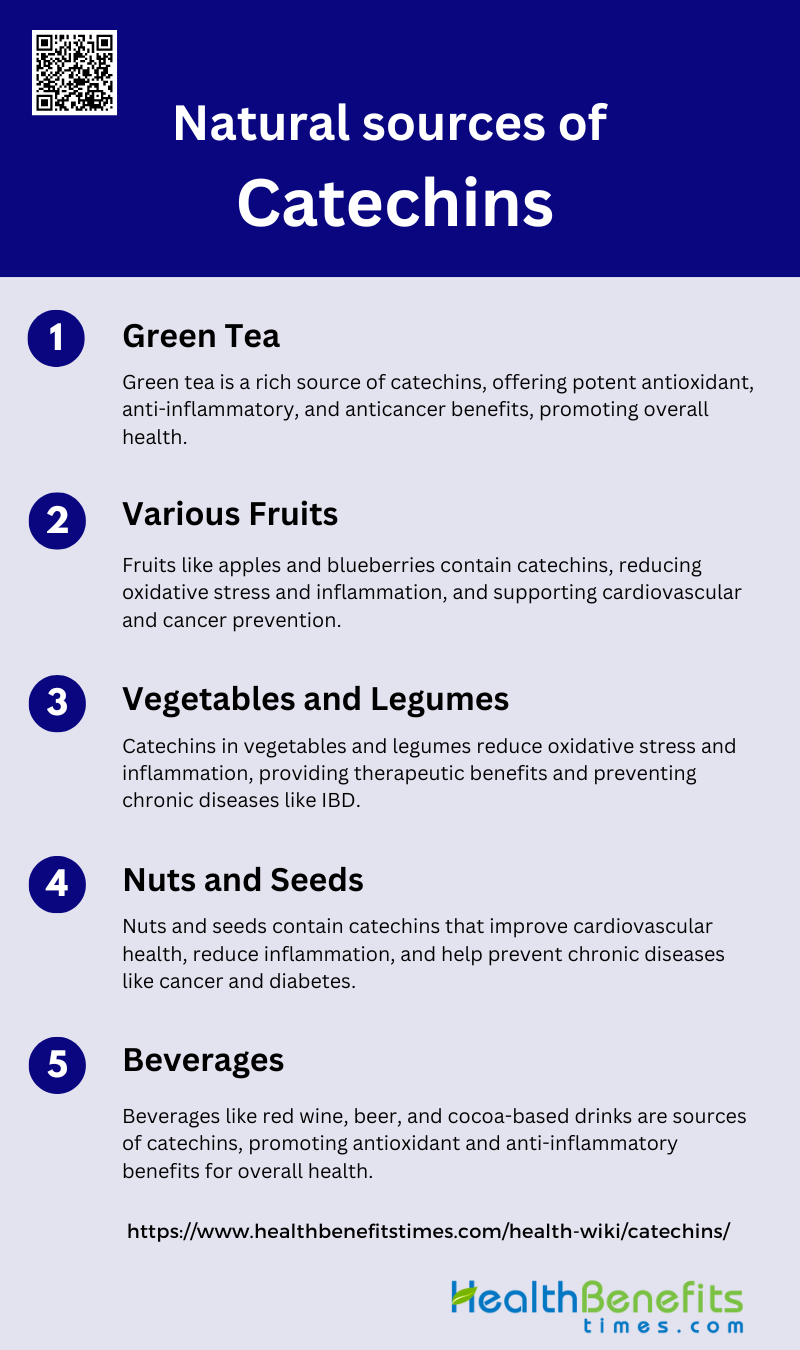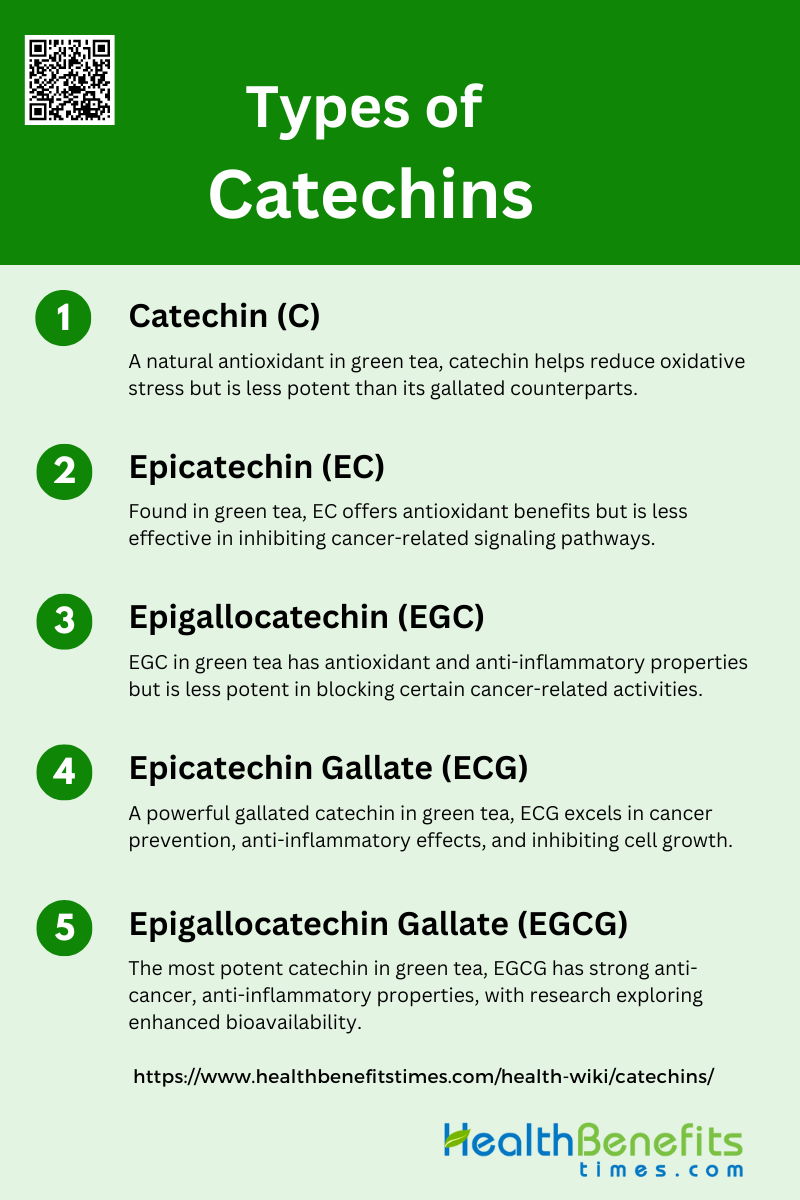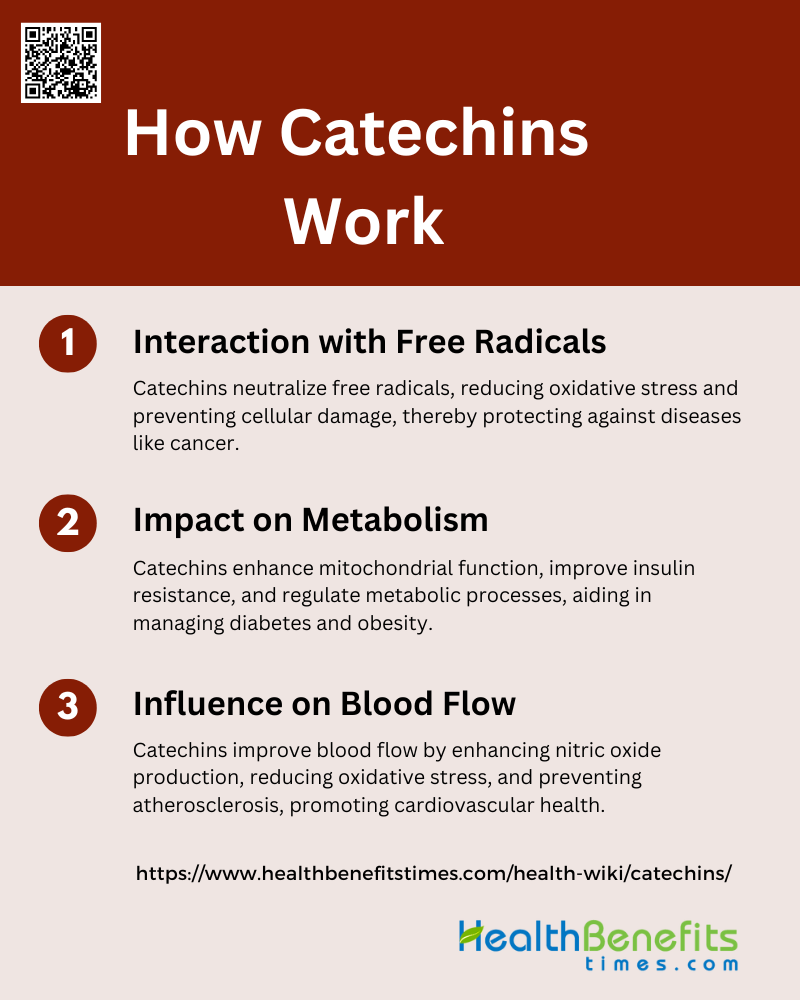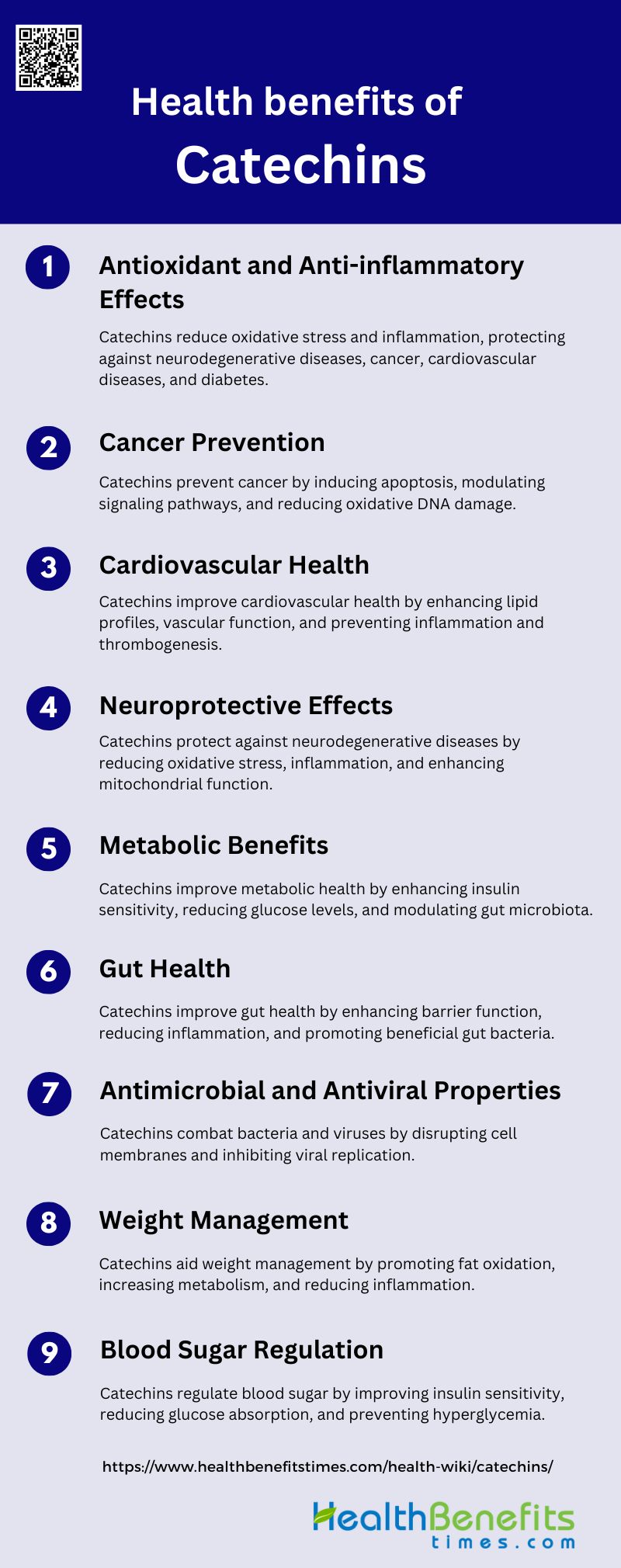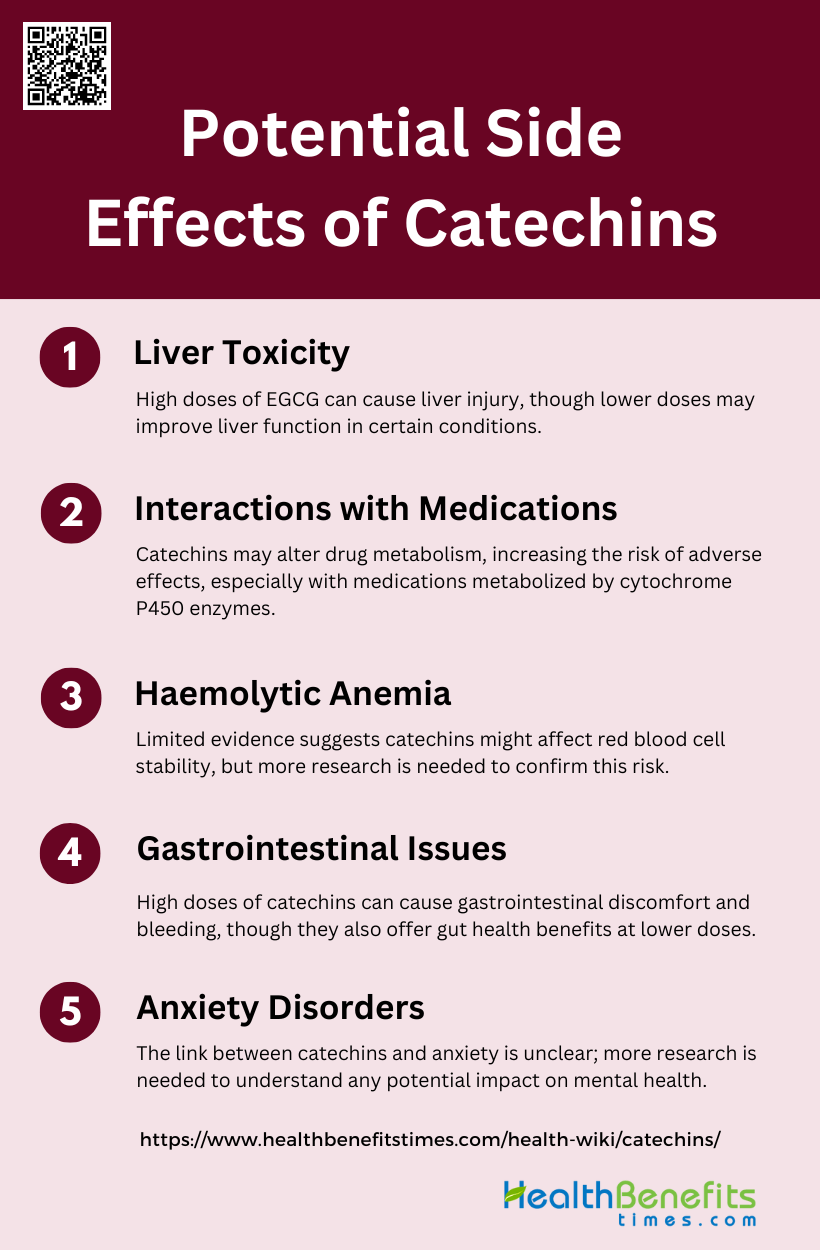Catechins are a type of flavonoid, specifically polyphenolic compounds, found abundantly in a variety of plants, most notably in tea leaves from Camellia sinensis. These compounds are renowned for their potent antioxidant properties, which help neutralize free radicals and reduce oxidative stress in the body. Catechins, particularly those found in green tea, such as (-)-epicatechin, (-)-epicatechin-3-gallate, (-)-epigallocatechin, and (-)-epigallocatechin-3-gallate (EGCG), have been associated with numerous health benefits. These include promoting weight loss, exerting anticancer effects, and providing anti-inflammatory benefits through mechanisms like stimulating AMP-activated protein kinase and enhancing apoptosis. Their ability to act as antioxidants makes catechins valuable in both food and nutraceutical applications, where they are used to enhance health and potentially reduce the risk of various diseases.
Natural sources of catechins
Catechins are a type of natural phenol and antioxidant found in various foods and beverages. They are known for their health benefits, including reducing inflammation and improving heart health. Below is a list of natural sources rich in catechins that you can incorporate into your diet:
1. Green Tea
Green tea is one of the richest natural sources of catechins, particularly epicatechin (EC), epigallocatechin (EGC), epicatechin gallate (ECG), and epigallocatechin gallate (EGCG). These compounds are known for their potent antioxidant properties, which help neutralize reactive oxygen and nitrogen species, thereby reducing oxidative stress. Regular consumption of green tea has been linked to various health benefits, including reduced body fat, improved liver function, and decreased risk of chronic diseases such as cancer and cardiovascular diseases. The high catechin content in green tea is also associated with anti-inflammatory and anticancer effects, making it a valuable dietary component for health promotion.
2. Various Fruits
Fruits are another significant source of catechins, with notable examples including apples, blueberries, gooseberries, grapes, kiwis, and strawberries. These fruits contain varying levels of catechins, which contribute to their antioxidant capacity. The consumption of catechin-rich fruits has been associated with numerous health benefits, such as reduced oxidative stress and inflammation, which can help prevent chronic diseases like cardiovascular diseases and certain cancers. The presence of catechins in fruits also supports their role in promoting overall health and well-being, making them an essential part of a balanced diet.
3. Vegetables and Legumes
Vegetables and legumes are also important sources of catechins, contributing to their health-promoting properties. Catechins in these foods help reduce oxidative stress and inflammation, which are key factors in the development of chronic diseases such as inflammatory bowel disease (IBD). The antioxidant properties of catechins in vegetables and legumes can inhibit oxidative damage and regulate immune cell activity, providing therapeutic benefits for conditions like IBD. Including a variety of catechin-rich vegetables and legumes in the diet can thus support overall health and reduce the risk of chronic diseases.
4. Nuts and Seeds
Nuts and seeds, though less commonly highlighted, also contain catechins that contribute to their health benefits. These foods are known for their antioxidant properties, which help combat oxidative stress and inflammation. The catechins in nuts and seeds can support cardiovascular health by reducing oxidative damage and improving lipid profiles. Additionally, the anti-inflammatory effects of catechins in these foods can help mitigate the risk of chronic diseases such as cancer and diabetes. Incorporating nuts and seeds into the diet can thus provide a valuable source of catechins and other beneficial nutrients.
5. Beverages
Apart from green tea, other beverages such as red wine, beer, and cocoa-based drinks are notable sources of catechins. These beverages contain various catechins that contribute to their antioxidant and anti-inflammatory properties. For instance, red wine and cocoa-based products are rich in catechins that help reduce oxidative stress and improve cardiovascular health. The consumption of catechin-rich beverages has been linked to numerous health benefits, including reduced risk of chronic diseases and improved overall health. Therefore, including these beverages in moderation can be a beneficial addition to a catechin-rich diet.
Types of Catechins
Catechins are a group of flavonoids found in a variety of plants, known for their antioxidant properties. They come in several different types, each with unique benefits and characteristics. Below is a list of the main types of catechins you should be aware of:
1. Catechin (C)
Catechin (C) is a type of natural phenol and antioxidant, belonging to the flavonoid family. It is found in various foods and beverages, including green tea, where it contributes to the health benefits associated with tea consumption. Catechins are known for their ability to scavenge free radicals, thereby reducing oxidative stress and potentially lowering the risk of chronic diseases such as cardiovascular disease and cancer. Although catechin itself is less studied compared to its gallated counterparts, it still plays a significant role in the overall antioxidant capacity of green tea. Catechin’s effectiveness in inhibiting certain cellular processes, such as the hepatocyte growth factor (HGF)-induced signaling, is less pronounced compared to other catechins like epigallocatechin gallate (EGCG) and epicatechin gallate (ECG).
2. Epicatechin (EC)
Epicatechin (EC) is another prominent catechin found in green tea, known for its antioxidant properties. Unlike its gallated counterparts, EC does not possess a galloyl group, which significantly affects its biological activity. Studies have shown that EC is less effective in inhibiting HGF-induced signaling pathways, such as Met phosphorylation and downstream activation of AKT and ERK, compared to other catechins like EGCG and ECG. Despite this, EC still contributes to the overall health benefits of green tea, including its potential to reduce oxidative stress and improve cardiovascular health. Its role in cancer prevention is less pronounced, but it still offers some protective effects due to its antioxidant properties.
3. Epigallocatechin (EGC)
Epigallocatechin (EGC) is a catechin found in green tea that has shown significant biological activity, although it is less potent than its gallated counterparts. EGC has been observed to inhibit HGF-induced AKT and ERK phosphorylation at higher concentrations (10 and 20 μM) but is incapable of blocking Met activation. Despite this limitation, EGC can still inhibit HGF-induced cell motility, suggesting its potential role in cancer prevention. EGC also contributes to the antioxidant and anti-inflammatory properties of green tea, making it a valuable component in the fight against oxidative stress and related chronic diseases.
4. Epicatechin Gallate (ECG)
Epicatechin Gallate (ECG) is a gallated catechin found in green tea, known for its potent biological activities. ECG has been shown to completely block HGF-induced signaling and cell motility at relatively low concentrations (0.6 μM and 5 μM, respectively). This makes it a promising candidate for cancer prevention and therapy. ECG also exhibits strong anti-proliferative and anti-inflammatory effects, particularly in pancreatic tumor cells, where it outperforms EGCG in inhibiting cell growth and modulating cell cycle regulatory proteins. Additionally, ECG has been found to suppress melanogenesis in melanoma cells, further highlighting its potential as a therapeutic agent.
5. Epigallocatechin Gallate (EGCG)
Epigallocatechin Gallate (EGCG) is the most abundant and well-studied catechin in green tea, known for its wide range of biological activities. EGCG has been shown to inhibit HGF-induced Met phosphorylation and downstream activation of AKT and ERK at low concentrations (0.3 μM), as well as block cell motility and invasion at higher concentrations (5.0 μM). EGCG’s anti-cancer properties are well-documented, with studies demonstrating its ability to modulate various cell signaling pathways, including those involved in proliferation, apoptosis, and angiogenesis. Additionally, EGCG has been shown to activate diacylglycerol kinase alpha (DGKα) via the 67 kDa laminin receptor, suggesting its potential in preventing diabetic renal dysfunction. Despite its poor bioavailability, strategies such as nanotechnology-based formulations are being explored to enhance its therapeutic efficacy.
How Catechins Work
Catechins are powerful antioxidants that help neutralize harmful free radicals in the body. They also possess anti-inflammatory properties and support cardiovascular health by improving blood vessel function. Below is a list of how catechins work:
1. Interaction with Free Radicals
Catechins, particularly those found in green tea such as epicatechin gallate (ECG) and epigallocatechin gallate (EGCG), are potent antioxidants that interact with free radicals to mitigate oxidative stress. These compounds act as free radical scavengers, neutralizing reactive oxygen species (ROS) and preventing cellular damage. Catechins achieve this by donating electrons to stabilize free radicals, thereby terminating the chain reactions that can lead to cellular damage and diseases such as cancer and neurodegenerative disorders. Additionally, catechins can chelate metal ions, further reducing the formation of ROS and protecting cellular components like DNA from oxidative damage.
2. Impact on Metabolism
Catechins have a significant impact on metabolism, particularly through their role in mitochondrial function. They help regulate mitochondrial biogenesis and function, which is crucial for maintaining cellular energy homeostasis. Catechins improve insulin resistance and regulate intracellular calcium levels, which are vital for metabolic processes. Furthermore, they influence epigenetic processes that can affect metabolic pathways. By enhancing mitochondrial efficiency and reducing oxidative stress, catechins contribute to better metabolic health and may help in managing conditions like diabetes and obesity. Their ability to modulate metabolic networks underscores their potential in therapeutic strategies aimed at metabolic disorders.
3. Influence on Blood Flow
Catechins positively influence blood flow by improving endothelial function and reducing oxidative stress in blood vessels. They enhance the production of nitric oxide, a vasodilator that helps in maintaining vascular health and improving blood circulation. This effect is particularly beneficial in preventing cardiovascular diseases. Catechins also reduce the formation of atherosclerotic plaques by inhibiting the oxidation of low-density lipoprotein (LDL) cholesterol, thereby promoting better blood flow and reducing the risk of heart attacks and strokes. Their antioxidant properties further protect the vascular system from oxidative damage, contributing to overall cardiovascular health.
Health Benefits of Catechins
Catechins are potent antioxidants found in various foods and beverages, known for their numerous health benefits. They help reduce inflammation, improve heart health, and support weight management. Below is a list of the key health benefits of catechins:
1. Antioxidant and Anti-inflammatory Effects
Catechins, polyphenolic compounds found in tea, exhibit potent antioxidant properties by scavenging reactive oxygen species (ROS) and chelating metal ions. They also induce antioxidant enzymes and inhibit pro-oxidant enzymes, thereby reducing oxidative stress. These properties are crucial in preventing diseases associated with oxidative stress, such as neurodegenerative diseases, cancer, cardiovascular diseases, and diabetes. Additionally, catechins possess anti-inflammatory effects by inhibiting the NF-κB pathway, which reduces the production of pro-inflammatory cytokines and adhesion molecules, thus mitigating inflammation.
2. Cancer Prevention
Catechins have shown promise in cancer prevention due to their antioxidant and anti-inflammatory properties. They can inhibit the growth of cancer cells by inducing apoptosis and cell cycle arrest. Catechins also modulate signaling pathways such as NF-κB and MAPKs, which are involved in cancer progression. Furthermore, their ability to scavenge ROS helps in reducing oxidative DNA damage, a key factor in cancer development. These mechanisms suggest that catechins could be effective in reducing the risk of various cancers.
3. Cardiovascular Health
Catechins contribute significantly to cardiovascular health by exerting multiple protective effects. They improve blood lipid profiles by inhibiting lipid biosynthesis and reducing intestinal lipid absorption. Catechins also enhance vascular function by activating endothelial nitric oxide, which regulates vascular tone. Their anti-inflammatory properties prevent vascular inflammation, a critical factor in atherosclerosis. Additionally, catechins inhibit platelet adhesion, reducing the risk of thrombogenesis. These combined effects make catechins beneficial in preventing and managing cardiovascular diseases.
4. Neuroprotective Effects
Catechins offer neuroprotective benefits by reducing oxidative stress and inflammation, which are key contributors to neurodegenerative diseases. They modulate signaling pathways such as NF-κB and Nrf2, which play roles in cellular responses to oxidative stress. Catechins also enhance mitochondrial function and reduce endoplasmic reticulum stress, further protecting neuronal cells. These properties suggest that catechins could be effective in preventing or slowing the progression of neurodegenerative conditions like Alzheimer’s and Parkinson’s diseases.
5. Metabolic Benefits
Catechins have been shown to improve metabolic health by alleviating conditions such as obesity, diabetes, and metabolic syndrome. They enhance insulin sensitivity and reduce fasting glucose levels, which are crucial for managing diabetes. Catechins also modulate gut microbiota, promoting the production of beneficial metabolites like short-chain fatty acids, which play a role in metabolic health. Additionally, their anti-inflammatory properties help in reducing systemic inflammation, a common feature of metabolic disorders.
6. Gut Health
Catechins positively impact gut health by improving gut barrier function and reducing intestinal inflammation. They decrease intestinal permeability, which helps in preventing the translocation of harmful substances into the bloodstream. Catechins also modulate gut microbiota composition, promoting the growth of beneficial bacteria and inhibiting pathogenic ones. These effects contribute to overall gut health and can alleviate conditions like inflammatory bowel disease and metabolic syndrome.
7. Antimicrobial and Antiviral Properties
Catechins exhibit antimicrobial and antiviral properties, making them effective against a range of pathogens. They can inhibit the growth of bacteria by disrupting cell membranes and interfering with bacterial enzymes. Catechins also show antiviral activity by inhibiting viral replication and modulating immune responses. These properties make catechins potential candidates for preventing and treating infections caused by bacteria and viruses.
8. Weight Management
Catechins aid in weight management by enhancing fat oxidation and increasing energy expenditure. They inhibit enzymes involved in fat synthesis and promote the breakdown of stored fat. Catechins also improve metabolic rate, which helps in burning more calories. Additionally, their ability to modulate gut microbiota and reduce inflammation contributes to weight loss and the prevention of obesity-related complications.
9. Blood Sugar Regulation
Catechins play a crucial role in regulating blood sugar levels, making them beneficial for individuals with diabetes. They improve insulin sensitivity and enhance glucose uptake by cells, thereby reducing blood sugar levels. Catechins also inhibit enzymes involved in carbohydrate digestion, slowing down glucose absorption. These effects help in maintaining stable blood sugar levels and preventing hyperglycemia, a key factor in diabetes management.
Catechins in Daily Diet
Recommended Intake
The recommended intake of catechins varies depending on the source and the specific health benefits being targeted. For general health benefits, an average daily intake of around 50 mg of catechins is common, as observed in the Dutch population. However, for specific health outcomes, higher doses may be more effective. For instance, a study on cognitive function used a daily intake of 336.4 mg of decaffeinated green tea catechins, while another study on body fat reduction used 690 mg of catechins daily. Therefore, while a moderate intake of around 50 mg may be beneficial for general health, higher doses may be required for specific therapeutic effects.
Best Sources for Daily Consumption
Tea, particularly green tea, is the most significant source of catechins in the diet. In the Dutch population, tea was the primary source of catechins across all age groups. Other notable sources include apples, pears, and chocolate, which are particularly important for adults and the elderly. Additionally, Mediterranean diets rich in fruits like plums, apples, strawberries, and grapes, as well as vegetables and red wine, also provide substantial amounts of catechins and procyanidins. Therefore, incorporating a variety of these foods into the daily diet can help ensure adequate catechin intake.
Tips for Maximizing Benefits
To maximize the benefits of catechins, it is essential to consider both the quantity and the quality of the sources. Consuming green tea regularly can significantly boost catechin intake, and opting for high-density catechin green tea can enhance health benefits such as improved liver function and reduced body fat. Combining catechin intake with other healthy behaviors, such as regular exercise, can further enhance benefits, as seen in studies where catechin consumption enhanced exercise-induced fat loss. Additionally, avoiding smoking and maintaining a high intake of fiber, vitamin C, and beta-carotene can synergistically improve the health benefits of catechins.
Potential Side Effects of Catechins
While catechins offer numerous health benefits, they can also have potential side effects when consumed in excess. These may include digestive issues, liver toxicity, and interactions with certain medications. Below is a list of potential side effects of catechins to be aware of:
1. Liver Toxicity
Green tea catechins, particularly epigallocatechin-3-gallate (EGCG), have been associated with liver toxicity in some cases. The European Food Safety Authority (EFSA) concluded that while green tea infusions are generally safe, doses of EGCG equal to or above 800 mg/day can lead to a significant increase in serum transaminases, indicating liver injury. Additionally, some preclinical studies and case reports have reported liver toxicities and acute gastrointestinal bleeding, which has led to stringent monitoring in clinical trials. However, other studies have shown that lower doses of catechins can improve liver function in conditions like non-alcoholic fatty liver disease (NAFLD).
2. Interactions with Medications
Catechins can interact with various medications, potentially altering their efficacy and safety. For instance, catechins have been shown to inhibit certain enzymes involved in drug metabolism, such as cytochrome P450 enzymes. This can lead to increased blood levels of drugs metabolized by these enzymes, raising the risk of adverse effects. The EFSA panel noted that while green tea catechins are generally safe, their interaction with medications should be carefully considered, especially at higher doses. Therefore, individuals taking medications should consult healthcare providers before consuming high doses of catechins.
3. Haemolytic Anemia
There is limited evidence directly linking catechins to haemolytic anemia. However, the antioxidant properties of catechins could theoretically affect red blood cell stability. While catechins are generally considered safe and have low toxicity, their impact on red blood cells has not been extensively studied. Most research focuses on their benefits, such as reducing oxidative stress and inflammation. Therefore, more studies are needed to conclusively determine any potential risks of haemolytic anemia associated with catechin consumption.
4. Gastrointestinal Issues
Catechins can cause gastrointestinal issues, particularly at higher doses. Some clinical trials have reported acute gastrointestinal bleeding and other adverse effects, which have necessitated stringent monitoring. Additionally, the EFSA panel noted that while traditional green tea infusions are generally safe, high doses of catechins in supplements can lead to gastrointestinal discomfort. Despite these potential issues, catechins have also been shown to have beneficial effects on gut health, such as reducing inflammation and improving gut barrier function.
5. Anxiety Disorders
There is limited evidence directly linking catechins to anxiety disorders. However, catechins have been studied for their neuroprotective effects and potential benefits in conditions like Down syndrome, which can include cognitive and emotional challenges. While catechins are generally considered safe, their impact on mental health, including anxiety, has not been extensively studied. Therefore, more research is needed to determine any potential effects of catechins on anxiety disorders.
FAQs
1. What are the differences between catechins and other types of flavonoids?
Catechins are a specific type of flavonoid, which is a broader category of plant compounds known for their antioxidant properties. Unlike other flavonoids, catechins are especially abundant in tea leaves and have unique properties that make them particularly effective in reducing oxidative stress and inflammation.
2. Can catechins help with weight loss?
Yes, catechins, particularly those found in green tea, are associated with weight loss. They help by increasing fat oxidation and boosting metabolism, which can aid in weight management when combined with a healthy diet and exercise.
3. How do catechins affect dental health?
Catechins have been shown to possess antibacterial properties that can help reduce the formation of dental plaque and prevent cavities. They also have the potential to inhibit the growth of bacteria responsible for bad breath.
4. Are catechins safe for pregnant or breastfeeding women?
The safety of catechins during pregnancy or breastfeeding is not well-studied. While moderate consumption of catechin-rich foods like green tea is generally considered safe, it is advisable for pregnant or breastfeeding women to consult a healthcare provider before taking catechin supplements or consuming high amounts of catechin-rich beverages.
5. Can catechins be taken with other antioxidants?
Catechins can be taken with other antioxidants, and doing so may even enhance their overall health benefits. However, it is essential to be mindful of the total intake of antioxidants to avoid potential adverse effects from excessive consumption.
6. Do catechins have any impact on skin health?
Yes, catechins can benefit skin health. Their antioxidant properties help protect the skin from damage caused by free radicals and UV radiation, potentially reducing signs of aging and improving overall skin appearance.
7. What is the best time of day to consume catechin-rich foods or beverages?
The best time to consume catechin-rich foods or beverages like green tea may depend on individual preferences and goals. For example, drinking green tea in the morning can boost metabolism and energy levels, while consuming it in the evening may not be ideal for those sensitive to caffeine.
8. Are there any differences in catechin content between hot and cold brewed tea?
The method of brewing can affect the catechin content in tea. Generally, hot brewing extracts more catechins from tea leaves compared to cold brewing. However, cold-brewed tea may still offer a significant amount of catechins, and some people prefer it for its milder taste.
9. Can catechins affect cholesterol levels?
Yes, catechins have been shown to positively affect cholesterol levels by reducing LDL (bad) cholesterol and increasing HDL (good) cholesterol. This can contribute to better cardiovascular health and a reduced risk of heart disease
10. How stable are catechins during cooking or processing?
Catechins can degrade when exposed to high temperatures, light, and oxygen during cooking or processing. Therefore, to preserve their beneficial properties, it is advisable to consume catechin-rich foods and beverages in their minimally processed forms.



